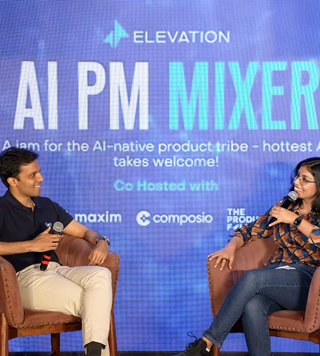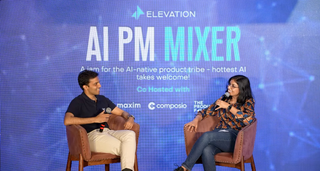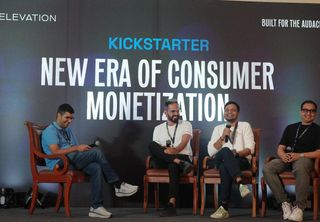How AI is Reshaping Product Management: Insights from Glean

Insights on Building Breakthrough AI Products for Enterprises from Glean's Garvit Juniwal

How AI is Reshaping Product Management: Insights from Glean

Insights on Building Breakthrough AI Products for Enterprises from Glean's Garvit Juniwal

At Elevation Capital's recent AI PM Mixer, Garvit Juniwal (Site Lead, India R&D at Glean), shared candid insights on building AI products at scale and how the role of product managers is fundamentally changing in the AI era in a fireside chat with Poorvi Vijay (Principal, Elevation Capital)
What followed was a masterclass in practical AI product development from someone who's been in the trenches—from his early days at Rubrik to his current role leading Glean's India R&D efforts.
The Enterprise AI Paradox
Perhaps the most counterintuitive insight Garvit shared was how AI has completely reversed the product-led growth (PLG) playbook that dominated enterprise software for the past decade.
"There was a time when people used to say PLG is the thing - you have to build an enterprise product that has to be product-led," Garvit explained. "I think AI has completely changed this. Now what I see is the Fortune 50 and Fortune 500 are the first adopters."
This reversal stems from a simple reality: smaller companies often lack the data, money, or necessity to leverage AI products effectively. The fear of sending data to LLMs that once blocked enterprise adoption? It's been replaced by FOMO. As Garvit put it: "What they know as a reality is that if they don't do it, their next-door neighbor is going to do it, and then they're going to be left behind."
From Requirements to Experiments: The New PM Playbook
The role of product managers is evolving from "someone who will design requirements to someone who will design experiments and effectively create the evaluation criteria," according to Garvit. This shift is profound because AI products are inherently fluid - think of ChatGPT's deceptively simple interface that can do almost anything.
For PMs looking to make this transition, Garvit offered practical advice:
- Get hands-on with AI tools: "Start playing around with both simple stuff like the OpenAI platform, to talk to GPT in a more raw form. Get a feel for what models respond and behave like across different model families."
- Understand the bounds: "A lot of PMs are either severely optimistic or very pessimistic about what an AI can do. And it changes every day as well."
- Don't forget business fundamentals: "Your ability to understand how you are going to create value and where the paycheck comes from is not going to change."
Interestingly, Glean has even created a new role -prompt engineers- who sit within the product organization. These aren't software engineers but rather a combination of PMs and data scientists who specialize in understanding and optimizing AI interactions.
The Infrastructure vs. Adoption Challenge
When asked what's harder- building the data infrastructure or driving user adoption- Garvit's answer was unequivocal: changing user behavior wins every time.
While Glean considers its knowledge graph across 100+ enterprise connectors as its moat, Garvit admitted: "I do not think this is an unsolvable problem. Given enough time, it's kind of known what you need to do. Changing user behavior has been definitively harder."
The solution? Meet users where they are. Glean's assistant appears in Slack threads "nearly magically when it feels like it can answer a question," eliminating the need for users to change their workflow.
Measuring Success in the AI Era
For a horizontal AI product like Glean, success metrics blend consumer and enterprise approaches:
- Consumer-style metrics: Daily active users, weekly active users, and retention rates remain crucial. "We measured our product in the same ways that you would measure a consumer product," Garvit noted.
- Enterprise validation: For cost centers like support, the metrics are clear—tickets resolved, time saved. But for knowledge workers? "You have to rely on user love," Garvit admitted. The ultimate validation comes when users "cannot imagine their life before they had Glean" or when they switch companies and "force their manager to buy Glean."
The Agentic Future (With Caveats)
While everyone's talking about agentic AI, Garvit offered a nuanced view. Yes, it's real - support teams at major banks have already reduced headcount by 20-30% using AI agents. But the "agent for X" trend where every tool gets its own AI agent? Garvit is skeptical.
"Tool proliferation problem is already there, and people have realized it. So it's not like they are going to be open to having 50 more tools," he argued. Instead, successful AI will be "intertwined in existing workflows" - invisible but contextual, like IDE coding assistants that help without disrupting how developers already work.
The Contrarian Take: Boring is Beautiful
When asked for his contrarian AI hypothesis, Garvit's response was refreshingly grounded: "The next shift in enterprise AI will actually come from taming complexity or solving some of the boring stuff."
His example? Employee onboarding - a repetitive, multi-stakeholder process that every company faces but few have automated effectively. It's not sexy, but it's exactly the kind of mundane, high-impact problem that AI can solve end-to-end.
Three Actionable Takeaways for PMs
- Start experimenting now: Don't wait for permission or the perfect use case. Use tools like ChatGPT, Claude, and others daily. As Garvit noted, "It's not that steep a learning curve at all."
- Focus on business value, not AI capabilities: "Always the fact that you have to solve a real business problem just remains. That has not changed with AI."
- Build for AI's strengths, not its deficiencies: "We have learned to put our trust in the fact that these things become better, rather than building for their deficiencies."
The Bottom Line
As AI reshapes product management, the fundamentals remain unchanged: solve real problems, measure what matters, and meet users where they are. What's different is the velocity of change and the need for PMs to become fluent in AI's possibilities and limitations.
Related

Vridhi: Reimagining Home Lending For Bharat's Self-Employed
Ram Naresh Sunku, Co-founder, Vridhi Home Finance
11.12.2024

Investing in Plena Data
Automating manual accounting tasks and improving employee experience with robots
14.10.2021

Monetization Strategies That Work: Insights from Consumer Tech Founders
Insights on what works when it comes to monetizing consumer apps in India.
10.12.2024